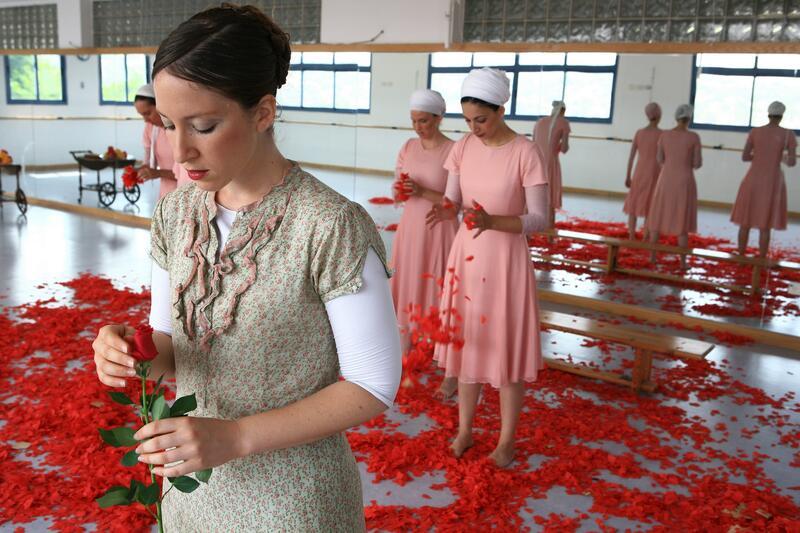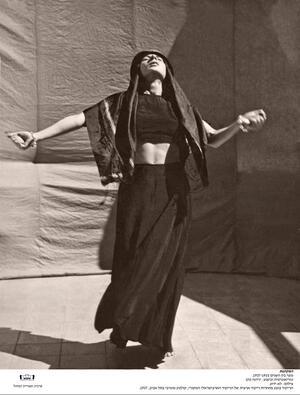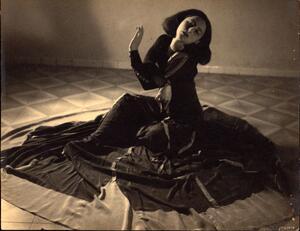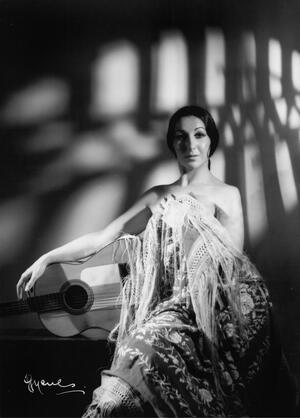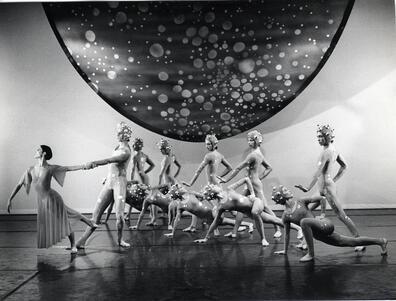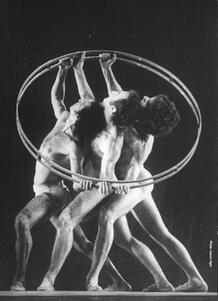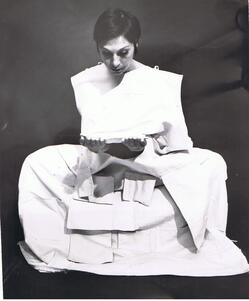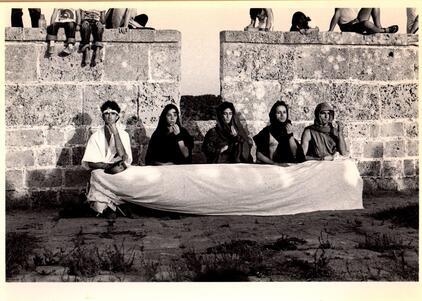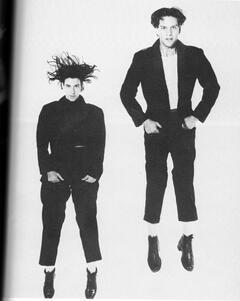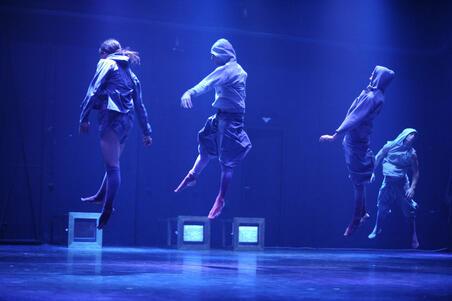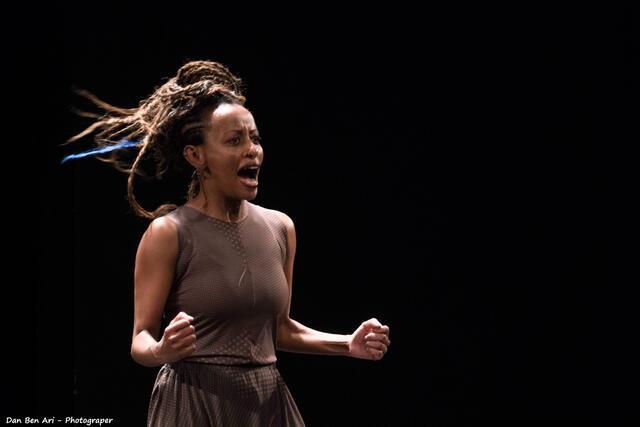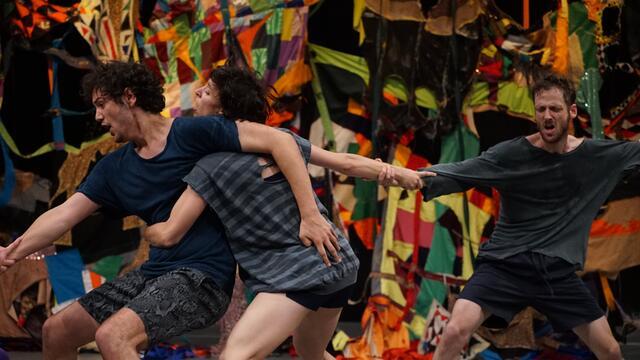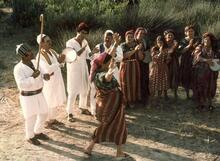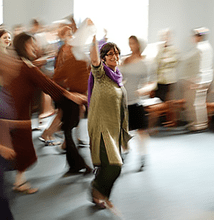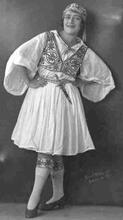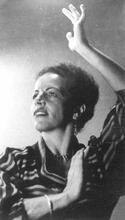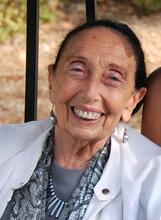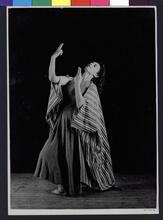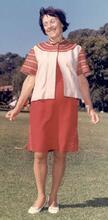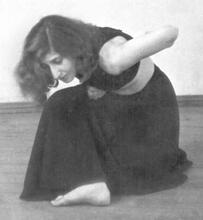Dance in the Yishuv and Israel
Concert dance first appeared in Israel in the 1920s, when artists began to try to create a new Hebrew dance. Israeli Expressionist Dance flourished during the 1930s and 1940s, but in the 1950s it was largely replaced by modern American dance, represented by Martha Graham. Israeli dance became increasingly professionalized and centralized during the 1960s and 1970s, with the formation of several new companies. Young Israeli “fringe” dancers and choreographers blossomed in the 1970s, with initiatives to promote local creativity accelerated in the 1970s and 1980s. Over the past few decades, ethnic dance companies have flourished, choreographers have taken increasingly political stances, and religiously observant men and women have been increasingly attracted to dance.
The Emergence of Concert Dance in the Yishuv
The building of a new culture was an important part of the realization of Zionism in Erez Israel (Land of Israel). Under the Ottoman Empire, and during the 40 years between the beginning of the First Aliyah (1882-1904) and the end of the Third Aliyah (1919-1924), the pioneers who arrived in the country with these waves of immigration came from Eastern Europe and Yemen. Except for the Yemenites, who came as families, most were young single idealists who came to help establish agricultural settlements.
As they settled in Eretz Israel, these immigrants sought to find ways of expressing themselves by building a new Hebrew culture. Questions covered almost all aspects of daily life, such as: How to dress in the hot climate? What kind of music should be played? What do we dance? Which language do we speak?
During this period, the Yishuv saw the beginnings of many cultural activities, but not the development of concert dance. Much has been said about how the pioneers danced ecstatically after their grueling day’s work in the fields. These were mainly eastern European folk dances, among them the Hora, Tcherkassia, and the Krakoviak, or dances for celebrations or social events. Concert dance was considered a luxury, and the only concert dance genre the immigrants recognized was classical ballet. But ballet was ideologically dismissed from the start, seen as representing the values of the old world and therefore unsuitable in content and aesthetics to the society they wanted to build.
The emergence of concert dance in the Yishuv depended on three major developments: First, the replacement of hostile Ottoman rule with the British Mandate. Second, the resumption of immigration after World War I, with whole families now arriving. These new immigrants settled in cities, established an urban audience, and supported culture. Among them were the first generation of concert dance artists: Baruch Agadati who arrived in 1920, Margalit Orenstein and her twin daughters Yehudit and Shoshana in 1922, Danya Levin in 1922, Rina Nikova in 1924, Lea Bergstein in 1925, and Deborah Bertonov in 1928. Third, the renewal of ties with Europe made it possible to travel and study with notable artists of the new Expressionist Dance (Ausdruckstanz). This style spoke to the pioneer generation because of its liberation from traditional restrictions and rules and its preference for personal expression and social involvement, which could express the intensity of the encounter with the ancient/new homeland.
Ornstein, for one, took advantage of long family visits in Europe to enroll her twin daughters in classes with some of the finest teachers, such as Rudolph von Laban, Jacques Dalcroze, Eleanor Tordis, and Gertrud Bodenwieser. Danya Levin, Ornstein’s former pupil, traveled to Berlin in 1927 to study with Juta Klampt and returned in 1931; Deborah Bertonov studied in Berlin with the Trompi Skoronel school and returned in 1932; and native-born Yardena Cohen studied with Gret Palucca in Dresden and returned in 1933. As part of their general education European Jews also sent their daughters to study Eurhythmics according the method developed by Swiss composer and educator Emil Jacques Dalcroze and the new movement styles of Isadora Duncan’s impressionism and Expressionist Dance.
The Search to Create Hebrew Dance
The pre-state era was notorious for its bitter and fundamental controversies on how to construct the new culture. Extremists argued that new art could grow only from Eretz Israel, not from elsewhere, while moderates believed “Hebrewness” lay in the fact that the place was Eretz Israel, those involved were Eretz-Israelis, and the text was in Hebrew. There was also ambivalence toward European Jewish culture that represented the very fact of the Diaspora.
The controversy in concert dance was less specific than in other areas, as most artists were passionate to create a new Hebrew dance. The exception was Vienna-born Margalit Ornstein who, like most German and Austrian Jews, regarded herself as a product of western European culture. Ornstein wrote: “Do not raise your voices to demand Hebrew art before we are Hebrews. Do not demand national expression in art before we arrive at a specific expression in our daily lives. Do not made the end come sooner!”
In dance, as in other arts, the aspiration was to create a culture that would be simultaneously modern and authentic. Modern involved a search for new techniques that would lend themselves to a new form of expression. It was also manifested in the attempt by the Yishuv’s gymnastics, eurhythmics, and dance teachers to create a new Hebrew body. Authenticity was necessary for socio-political identification, to highlight the society’s communal and ancient past— notably in the Bible. Turning to local landscape and scenery was considered authentic because it touched on nature (vegetation, colors, light) that persisted from the Biblical era. Although reservations about Jewish culture in the Diaspora were widespread, Jews of Eastern Europe were still understood as making a spiritual contribution, especially through Hasidic dance. The hope was that a synthesis embracing past, present, and future, reflected in the combination of the modern and the authentic, would produce an original Hebrew dance form.
Early teaching reflected efforts towards the “modern.” Margalit Ornstein founded the Yishuv’s first dance studio and taught—as the European dance community termed it at the time—“rhythmic gymnastics and plastic dance.” Ornstein imparted tools for self-expression through improvisation and composition, developing rhythm and musicality, and improving physical fitness. In the 1920s and through the mid-1930s, hers was the only place that taught dance, which she did with her daughters.
The 1920s and 1930s were unique in the passion of artists who sought their own individual paths to create Hebrew concert dance. Most were women, as concert dance was seen as feminine and men who wanted to dance generally joined folk dance troupes. The women dancers were recognized as educated and belonging to the cultural elite. Some also wrote poetry, painted, or directed movies. They brought with them the idea that making dance was a vocation, a sacred art. They were individualists, saw themselves as pioneers in modern dance, and were jealously protective of their methods and did not cooperate. A student who moved from one teacher to another was seen as a traitor.
Rina Nikova (1898-1972), a graduate of the St. Petersburg Academy of Ballet who immigrated from Russia to Israel in 1924, founded the Yemenite Company (also called the Biblical Ballet) in 1933. Earlier she had been a ballerina in the Eretz Israel Opera of Mordechai Golinkin (1924-1927); working with a small group of girls with no professional background in ballet, she set up dances for the opera. When the Opera closed, Nikova travelled to the United States to start a career as a dancer. Returning to Palestine in 1931, she assembled a group of girls of Yemenite descent. As Nikova put it, the Yemenite ensemble was designed “to put the illustrious heritage of our ancient past upon the stage. The ensemble’s dancing differs from expressive or folk dance in that it is more theatrical, more literary and decorative, and has less to do with the purity of movement.” The company conducted a successful tour in Europe between 1936 and 1939 but disbanded with the outbreak of World War II.
Dancer and choreographer Yardena Cohen (1910-2012) was particularly exceptional. Sixth generation on her father’s side, Cohen saw herself as native to the Land, remarking, “The rhythms of the Fathers are in the soles of my feet, the paths of Metulla in the Galilee are in my blood and I drink the view. It’s all so close to me, so much a given.” She was directly influenced by portraits of Biblical women, as well as by the country’s landscapes. Her non-native-born students saw in her “the authentic Eretz Israeli” character. In her lessons, she focused on providing educational and cultural values, as well as a feeling of closeness to nature in general and to Eretz Israeli scenery in particular. In 2010, at the age of 101, she received the Israel Prize in recognition of her life’s work in dance.
Influenced by anthropological research, Devorah Bertonov (1915-2010) sought inspiration for the creation of Hebrew dance in the human body. Bertonov immigrated in 1928 with her actor father, Yehoshua Bertonov. After creating short dance-pantomimes of Jewish topics, she created her important full-program work Exodus from Egypt (1946), which later became Memories of a People (1957). In 1991 she received the Israel Prize in recognition of her life’s work in dance.
Most of the arriving pioneers were secular and needed a new form of holidays and ceremonies in place of religious ones, one that could serve internally as the expression of a unifying framework and outwardly as representative of the new spirit. They staged pageants, which were a combination of Hebrew texts recited and sung together with festive and ceremonial dances, performed by entire agricultural communities in open air. Among the outstanding choreographers were Leah Bergstein and Yardena Cohen, whose work was a model for other artists in the 1930s and 1940s.
Eretz Israeli Expressionist Dance
What started with very humble beginnings by individuals in the 1920s took a different turn in the mid-1930s, when the Nazi rise to power brought professionals of Expressionist dance to Palestine. The new immigrant dancers worked under difficult conditions; the country was coping with the absorption of large numbers of Jewish refugees, a deficient infrastructure, and an exhausting climate.
Prominent figures who arrived in this period included Tille Rössler, who had been the senior instructor at the School of Gret Palucca in Dresden; Else Dublon who upon arrival gave solo performances in which she accompanied herself singing Yiddish songs and established a dance studio in Jerusalem, as well as Paula Padani who performed recitals before leaving for Paris Katia Michaeli who became an important instructor. Prior to their arrival they had all danced in Mary Wigman’s company.
The most important dancer to arrive in the 1930s was Gertrud Kraus (1901-1977), who became the leading figure in Yishuv dance, both as an artistic authority and because of the scope of her activity. Prior to her 1935 immigration, Kraus was already recognized as one of Europe’s leading lights in Expressionist dance. She immigrated, at the height of her career as a dancer, bringing with her a solo repertoire of 60 dances. Once in Eretz Israel she created her most experimental work, Impression of Eretz-Israeli Landscapes, a suite danced in silence, with minimalist solos and a transition from realism to the abstract. Kraus also opened a studio in Tel Aviv where she taught and trained dancers for her first company.
The arrival of the professional Expressionist Dance practitioners signaled a new track. Unlike the veteran pioneers, they did not seek to create a new movement language to express themselves in the new country. They were proud to belong to the Expressionist dance style that provided them with a sufficiently extensive and open framework within which to delineate universal, individual and even nationalist ideas.
With the outbreak of World War II, cultural contact with Europe was lost again. Dance artists in the Yishuv entered a period of cultural isolation, which continued through the Israeli War for Independence, until the early 1950s. Audience demand remained high, and the disconnect from Europe heightened reliance on local availability. The highlight of these artistic endeavours was the modern dance company founded by Gertrud Kraus and associated with the Folk Opera (1941-1947). Kraus created original dances for the operas and choreographed full evenings of dance for her company. During the 1940s her students became important dancers in their own right, including Naomi Alesovsky, Rachel Talitman, Vera Goldman, and Hilde Kesten. Other dancers who appeared in recitals or with their students were Yehudit and Shoshana Ornstein, Hassia Levi-Agron, and Rachel Nadav.
This was a difficult time, as news was arriving from Europe about the atrocities perpetrated on the Jews in the Holocaust. The Allies’ victory at El Alamein (1942) had removed the mortal danger to the Yishuv from General Rommel, but there was unrest at home. All this prompted a shift towards a lighter dance, as part of the escapism needed by the audience.
The 1950s: Twilight
After 1948, Israel needed to heal from the wounds of the War for Independence. The first years after the establishment of the state were years of austerity. Food and clothing were rationed through coupons. The trauma of the Holocaust hovered over everything. The land was covered with tents housing Jewish refugees from Arab countries and survivors from Europe, and there was a trickle of immigration from the United States. These demographic changes spawned the cultural perception of the “melting pot,” that is, the idea that people should spurn the cultural characteristics of the individual Jewish ethnic communities from which they came and instead create from this variety of cultures and styles one single core style that would be “Israeli.”
In the first half of the 1950s, after a long period of cultural isolation, guest companies began to arrive from Britain, France, and the United States. It was now possible to compare what had been accomplished in dance in the Yishuv and Israel with what had been done in other countries. It became clear that Expressionist Dance had almost disappeared from the world dance map, as it was regarded as German and some of its most notable artists had collaborated with the Nazis; the spotlight was now on modern American dance.
Immigrant dancers from the United States, including Ruth Harris (1950–1971), Rina Shaham (1951-2004), and Rena Gluck, brought the new American dance form with them. Harris, born in Berlin and trained as a ballet dancer, fled to the United States when the Nazis came to power; there she studied jazz, and worked in nightclubs before immigrating to Israel, where she became the country’s first jazz teacher. American-born Shaham studied with stage director Benjamin Tzemach and Martha Graham; she emigrated to Israel with her Israeli-born husband in 1951. Gluck was born in New York and studied with Blanche Evans, at the New Dance Group School, and at Julliard; she emigrated to Israel in 1954 with her Israeli-born husband. Like previous generations, they gave recitals, taught, and, under difficult conditions, founded semi-professional companies that broke up after a few performances.
Martha Graham’s historic visit to Israel in 1956, which took place at the initiative of Bethsabée de Rothschild (1914-1999), generated enthusiasm and admiration. There was a sense that 30 years of Expressionist dance had been “wasted” and that now the Israeli dance community needed to catch up and start mastering the new style of dance. Young dancers turned their backs on their teachers and choreographers, regarding them as outdated, and in unison passionately embraced Graham’s style, which they studied with Rena Gluck and Rina Shaham.
While Shaham and Gluck were young dancers at the start of their careers, the American Anna Sokolow was a veteran and respected choreographer. She was invited to Israel in 1952 at the recommendation of Jerome Robbins to train the Inbal company. She also held workshops, created a number of works, and established the Lyric Theatre (1962-1964), funded by the America-Israel Cultural Foundation and based solely on Sokolow’s works. But Sokolow never settled in Israel, and during the months she was overseas, the company could not work because she did not allow other choreographers to create dances for the Lyric Theatre.
While American modern dance was dominant in the 1950s, it was not always popular with audiences and critics. Unlike Expressionist Dance, whose codes were accessible to audiences, the American dance made in Israel was seen as uncommunicative and pretentious. At first, critics preferred to focus on what impressed them (professionalism and the improvement in the dancers’ technical ability), and they believed that time was necessary to build a bridge between American dance and the audience. But soon it was no longer possible to ignore that it drove audiences away.
In the early 1960s, it became apparent that dance was going through a serious crisis for various reasons, including an artistic impasse, loss of audience, and the lack of government support that would have allowed for the establishment of a professional company. These were reflected in typical headlines such as: “Dance of the Hopeless” and “Artistic Dance in Israel—A No-Man’s Land.” More and more dancers left the country.
Nevertheless, in 1949, Sara Levi-Tanai founded the Inbal Dance Theater, a concert dance company that drew inspiration from Yemenite cultural tradition. At the recommendation of Jerome Robbins, the dance company became the first to operate with regular financial support and was invited to tour the United States in 1957. The company’s star was Margalit Oved. Inbal was viewed throughout the world as the exponent of Israeli artistic dance. Yet in Israel itself, it was perceived more as a folklore group and remained outside the main circle of artistic activity.
Another important development during the 1950s was Noa Eshkol and Abraham Wachman’s invention of the Eshkol-Wachman movement notation, which is based on geometry and mathematics and enables the objective description of all possible movements and their combinations. The notation is used in dance, research, and teaching.
And Classical ballet? Although it was identified with old-world values, seeds of classical ballet sown during the 1930s managed to survive. The dancer Valentina Archipova-Grossman, originally from Latvia, opened a ballet studio in Haifa in 1936, shortly after dancer Mia Arbatova opened one in Tel Aviv in 1934. Grossman focused on teaching, while Arbatova not only established generations of dancers but also put on ballet programs. During the 1950s, Arbatova and her partners Elisheva Mona, Mia Pick, and Irena Getri founded the Folk Ballet (1949-1950) and encountered harsh hostility. Dance critic Shlomit Roth, for example, viewed ballet as the enemy of birth, which was regarded at the time as a national mission. The Israel Opera (1947-1982), founded by Edis de Philippe, established a ballet company, but the work was not steady and the standard was low.
Professionalization and Imitation
In the 1950s, several of the younger generation of Israeli dancers studied at the Graham school in New York, but with no professional company to return to, there was a sense that, unless drastic measures were taken, modern American-style dance would soon go the way of Expressionist Dance. Then, in 1964, Bethsabée de Rothschild established the Batsheva Dance Company, which gathered the best dancers in the country, especially Rina Schenfeld and Rena Gluck. Rothschild decided that as long as no prominent local creative power existed, the new company would be based on well-known choreographers from abroad. Graham consented to serve as artistic advisor and even allowed the company to perform seven of her pieces. The starting point was high. Moshe Natan wrote: “Baroness Bathsheba de Rothschild’s new dance company has burst like a storm upon the desert that is Israeli dance and has achieved the impossible. This was truly a victory” (Natan, Bema’ha’neh). From then until the late 1970s, almost every dance activity or company that emerged was measured according to the high standards Batsheva set and the Graham style it represented, heightening the loss of faith in Israeli choreographers.
Rothschild soon became embittered that Batsheva, which performed brilliantly on stage, suffered from a severe lack of discipline off stage. She asked to appoint ballet dancer Jeannette Ordman to lead the company, but the dancers rejected Ordman’s artistic authority. In 1967, Rothschild set up another company, Bat-Dor, under Ordman’s artistic direction. While Batsheva was identified with Martha Graham's work, Bat-Dor combined modern dance techniques with classical ballet, following a similar route to that taken by European modern dance companies of the period. Both companies’ world tours put Israel on the map of international dance and improved the technical level of Israeli dancers. They competed with each other in bringing choreographers from abroad, with the result that local creativity dried up even more.
The 1960s and 1970 saw the establishment of several new companies. The Israel Ballet, a classical ballet company, was founded in 1968 by Bertha Yampolsky and Hillel Markman. A year later, the A voluntary collective community, mainly agricultural, in which there is no private wealth and which is responsible for all the needs of its members and their families.Kibbutz Contemporary Dance Company, directed by Yehudit Arnon, was formed. In 1978, dancer and choreographer Moshe Efrati left Batsheva to form the Kol Dmama (Voice Silence) troupe, which at first had both deaf and hearing members.
The Six-Day War (1967) aroused Zionist feelings in the many Jews in the diaspora who decided to immigrate to Israel. The two mass immigrations from the Soviet Union (first in the early 1970s and second in the early 1990s) expanded the classical ballet-loving audience and enriched the pool of dancers in this genre. Ballet dancers Valery and Galina Panov, the most celebrated of the Russian refuseniks, arrived in 1974; Panov and his second wife Ilana formed the Panov Ballet in Ashdod in 1998. The most celebrated of the immigrant dancers in the second mass immigration was Nina Timofeeva, a former Bolshoi ballerina, who settled in Jerusalem and taught at the Jerusalem Academy for Music and Dance. She went on to establish a school in 2004, and, together with her daughter Nadia, the Jerusalem Ballet in 2007.
Following the Six Day War, South Africa-born Silvia Duran, who had been a soloist in leading dance companies in Spain, immigrated to Israel and opened a school in Tel Aviv, where she taught generations of Flamenco dancers. Lia Shubert, born in Vienna, was a soloist for the Malmö Municipal Theater in Sweden and founded the Swedish Academy of Ballet in Stockholm, a government institution for the training of dancers and teachers. Together with Caj Lotman (Selling), ballet star of the Royal Swedish ballet, Shubert established a school and the Dancers Stage group (1972-1980) in Haifa.
The Rise of the Fringe
The lack of confidence in local artists that led to a wasteland of local creativity started to change in the late 1970s. First, a group of young Israeli choreographers returned to Israel from the United States, bringing with them their experiences of American post-modern dance and experimental theater that replaced text with movement. They included Rachel Cafri, who studied with Merce Cunningham; Heda Oren, who studied with Alwin Nikolais; Ruth Ziv-Ayal, who studied at New York University; and Ronit Land, who returned from a course in Britain for young choreographers in the “New Dance” style, also inspired by American post-modern dance. Second, the arrival of Pina Bausch Wuppertal Dance Theatre from Germany in 1981 brought the German Tanztheater style (literally, dance-theater, but recognized as the German style of movement-theater). Third, audiences had become weary of the mostly dramatic and mainstream repertoire staged by Israel's major dance companies, and there was hunger for experimental work.
After decades of neglect of Israeli choreographers, a burst of creativity ensued in the 1970s and 1980s among a new group of independent choreographers, whose goal was to stimulate creativity, to grow a young generation of Israeli choreographers, and to experiment with the new ideas, searching for a language of movement based on everyday movements and looking for their own voice. They created a rich fringe work, in which objects constituted integral parts of the choreography.
In 1976, Ruth Ziv-Ayal choreographed her first work in the movement-theater style. In 1977, dancer Ruth Eshel gave her first dance recital in the style of post-modernism and movement-theater, created for her by choreographers Ronit Land, Heda Oren, Ruth Ziv-Ayal, and Rachel Cafri. In later recitals, Eshel choreographed her own programs as well as for established chamber ensembles; her works related to natural materials and ritual, and she collaborated with sculptors Avraham Offek and Dalia Meiri and composer Tsipi Fleischer.
In 1977 the Batsheva 2 company staged works by Rachel Cafri, Heda Oren, Ronit Land, and stage director Miri Magnus, and Dorit Shimron founded the Tnuatron ensemble, a company of young girls who combined dance and acrobatics inspired by the American Pilobolus Dance Theatre. In 1978 Rina Schenfeld appeared in her first solo recital, followed by many others in which she experiments with objects, and Flora Cushman established the Jerusalem Dance Workshop. Nava Zuckerman founded the Tmu-Na company in 1982; during the 1990s, she established the Tmuna Theatre in Tel Aviv, which hosts experimental interdisciplinary works by young artists. The Mirali Sharon Dance Company (1980-1986) and The Oshra Elkayam Movement Theater (1983-2000) were established by these veteran choreographers, who were among the few choreographers who created for Batsheva and Bat-Dor. These were followed by, among many others, the Tamar Ramla Dance Theater (1982-1984); the projects of choreographer Tami Ben Ami and dancer Sally Anne Friedland, who explored body possibilities and used gibberish texts (1983-1992); the all-female co-operative Magma ensemble (1984-1988); and The Jerusalem Dance Theater formed by Tamara Mielnik (1985-present).
Most of these new independent choreographers did not yet feel adequately mature as choreographers to reflect the complexity of the Israeli political reality in their work. Exceptions were the two Tamar dance troupes, which dealt with difficult social and political topics of Israeli society. The first Tamar—Tamar Company (Teatron Mahol Ramla, or Ramlae Dance Theatre, 1982-1984)—was a collective company inspired by post-modern dance based on Israeli ex-Batsheva dancers who had returned to Israel after living in New York. After its breakup because of money difficulties, Tamar- Ramla was re-established in 1987 as Tamar-Jerusalem, under the artistic direction of Amir Kolben with an increased influence of German movement-theatre. Reviews of Kolben’s political works were mixed, not because of their content but for the manner of their translation to the stage. Tamar Jerusalem closed in 1992.
The independent artists’ initiatives brought a change in attitude of the Public Council for the Arts’ dance department, headed by Nily Cohen. Until then, the policy was to support only large institutionalized companies, and, in exceptional cases, individual projects. Recognizing the importance of the independents and the urgent need to support Israeli choreographers, the Council established a special track to support the independents and encourage experimental work. In 1984, the Council also established the yearly festival Shades of Dance, which provided a professional stage and public exposure for young fringe artists.
The first big discovery of Israeli talent occurred in Shades of Dance 1987 when Liat Dror and Nir Ben-Gal created the duet Room Apartment. They demonstrated that a pair of little-known, independent, and local choreographers using contemporary choreographic tools can achieve a true statement. A year later they won first prize at the Bagnolet Choreography Competition in Paris with the same piece, which was the impetus for many invitations to tour overseas.
Flowering
A number of simultaneous developments in the late 1980s moved dance into high gear a decade later: In 1989 the Suzanne Dellal Center was established by the Dellal family, the Public Council for the Arts, and the Tel Aviv municipality; the center was directed for 30 years by Yair Vardi. The center was named for the Dellals’ daughter Suzanne, who loved dance and died in her early twenties of cancer. For the first time, dance in Israel had a home, one that initiated new frameworks for professionally staged projects and set up International Exposure in 1995 in order to reveal dance in Israel to buyers from abroad. For the first time, two Israeli choreographers, Ohad Naharin and Rami Be’er, who headed Batsheva and the Kibbutz Contemporary Dance Company, guided their companies to an artistic pinnacle. In 1990, the yearly Arbatova Ballet Competition for young ballet dancers was established and the Haramat-Masach (Curtain Up) competition was founded by the dance Public Council for the Arts, another yearly stage for experienced choreographers who had “graduated” from Shades of Dance.
A generation of Israeli choreographers with small, high-quality ensembles made their way through the Shades of Dance and Curtain Up festivals. Among them were choreographers Noa Dar, who created her unconventional and compelling Tetris (2007) in which she investigates borders and challenges spectators and performers alike; Anat Danieli, who creates delicate dances that relate to where she is in life; Tamar Borer, a Butoh-style dancer who was involved in a serious car accident that left her paralyzed in both legs but continues to dance professionally with a unique movement language; Idit Herman, who with Dimitry Tyulpanov established Clipa Theater creating extravagant Total Theater; Ronit Ziv, whose movement research is based on the relationship between text and choreography; Nadine Bommer who gets her inspiration from the human behaviors of colorful types and turns them into grotesque, theatrical, and circus-like characters; and Butoh dancer Maya Dunsky.
The Choreographers Guild was set up in 1998. Its goal was to get government support for its members, become an influential voice in the field of Israeli culture, improve working conditions for dancers and choreographers, acquire comprehensive government and legal backing, and develop public awareness of dance. As of 2019 it included 60 active choreographers, most of whom are women.
Prominent Contemporary Ensembles
In 1992 Noa Wertheim and her husband Adi Sha’al performed their duet Vertigo, in which the young couple described their relationship as a state of dizziness, like the vertigo associated with pilots. The work was received as very Israeli, tied to the here and now because Sha’al had participated in the pilot training course in the Israeli Force Defense prior to becoming a dancer. The couple created several successful programs and established the Vertigo Dance Company in 2009. Vertigo’s dance style can be described as virtuoso, optimistic, and acrobatic, yet it is also humane, leaving room to breathe and paying attention to the body. Vertigo was among the first Israeli ensembles to use capoeira martial arts techniques and contact improvisation.
Gradually Wertheim became Vertigo’s choreographer and Sha’al concentrated on management. Born in New York to a Modern Orthodox family, Wertheim grew up in Netanya, and her choreography is informed by her religious upbringing. Jewish sources provide her with inspiration. For example, in Manna (2009; Aramaic for vessel of light), she asked which comes first, darkness or light, and proposed Manna as a philosophical and mystical journey between these two opposites. Because of the responsibility the company felt toward the environment, Wertheim created Birth of the Phoenix (2004), which investigated the relation between humans and nature; the work was performed in the open under a portable geodesic metallic dome, with the dancers performing in it and the audience sitting in a slightly elevated defined circular space. Another outstanding work was White Noise (2008), about the phenomenon of noises that “penetrate the body and disrupt the systems of thought and rhythm of breathing” (from the program). Vertigo also created a special track to work with disabled people. In 2007, Vertigo moved to Kibbutz Ma’aleh HaHamisha in the Jerusalem Hills, where they built an ecological dance village. In 2018, it became one of the major four dance companies in Israel, with Batsheva, Kibbutz, and the Israel Ballet.
In 1998, choreographer and dancer Inbal Pinto and her husband the actor Avshalom Polk formed the Inbal Pinto and Avshalom Pollak Dance Company. Their work operates in a human fantasyland peopled by dwarves, giants, and other strange and marvelous creatures. “One enables escape to a fictitious reality, one that you can still identify with, but not necessarily understand that you’re a part of,” said Pinto (interview with author). The dance that propelled the couple to local and international acclaim was Oyster (1999), set in a circus or traveling theater, a venue identified with the freedom to wander. The couple created many excellent full-program works, including the outstanding Bombyx Mori (2011) and Waterflower (2014). The company became internationally known with many successful tours abroad. In 2019, after their marriage broke apart, Pinto left the company and continues to create as a freelancer choreographer.
Sharon Eyal’s unique movement language is born out of Ohad Naharin’s Gaga, which she expands and uses in a way that reflects her sensual imagination. She creates an amazingly beautiful imaginary tribal world where her dancers move like people from another culture, simultaneously full of passion and marvelously delicate. Eyal was born in Jerusalem and danced with the Batsheva Dance Company between 1990 and 2008, where she was Naharin’s muse. She served as associate Artistic Director for Batsheva between 2003 and 2004 and as a House Choreographer for the company between 2005 and 2012. In 2013 she launched L-E-V (the Hebrew word for heart is “lev”) with her long-time collaborator Gai Behar. Among her outstanding works are Bertolina (2006), Killer Pig (2009), Ocd Love (2015), and the Brutal Journey of the Heart (2019). The company performs in the most prestigious festivals in the world.
Yasmeen Godder’s work represents and deconstructs images, words, sounds, and symbols of Israeli politics. She also questions the male and the female gaze as well as the fundamental dynamic in the performing arts, that between artist and audience. Her style incorporates obsessive and tension-filled movement phrases. Among her full evening-length works are Sudden Birds (2002), Two Playful Pink (2003), I'm Mean, I Am (2006), Love Fire (2009), Storm End Come (2011), and Lie Like A Lion (2014), a solo work exploring the archive in her own body. In 2015 the Yasmeen Godder Company collaborated with Theatre Freiburg on a year-long project, Störung/Hafra’a, which won the inaugural Shimon Peres Prize in 2017 for its innovative approach to bringing together professional dancers, scientists, and people living with Parkinson’s disease to research movement collaboratively. Godder held two international conferences around Parkinson’s disease, dance, and community: “Störung/Hafra’a” (2016) and ‘“Moving Communities” (2018). In 2007 she opened her own studio in Jaffa. She is the recipient of numerous awards including a 2001 New York Dance and Performance “Bessie” Award.
Bridging the Cultural Gulf
In the first decades after the establishment of the state of Israel, there was a gulf between the Ashkenazi, Mizrahi, and Sepharadi Jewish communities. Those who performed Sephardi and Mizrahi belly dances at parties or onstage were regarded as cheap and "tarty." By contrast, the policy of cultural pluralism that influenced social and cultural discourse in the 1970s increased Israelis’ readiness to bridge the cultural gulf between the Jewish communities and between the Jewish and non-Jewish communities.
Israel is home to many ethnic dance companies: Arab, Bukharan, Russian, Caucasian, Druse, Yemenite, and Ethiopian. In 1995 Haim Shiran, director of Inbal, established the Inbal Multi Cultural Ethnic Center, located in the Suzanne Dellal Center. The son of Moroccan Jews, Shiran had long wanted a venue that would be a home for all of Israel’s Mizrahi communities. Because he was not a dancer person but rather a television director, as well as a lover of music and literature, his vision was to create a multidisciplinary ethnic center of which the Inbal Dance Theater became a part. A year later Ilana Cohen, principal dancer and choreographer for Inbal, became the Center’s associate artistic director. In 2008 they were replaced by Raz Amitay.
The turning point occurred when Liat Dror and Nir Ben-Gal (Ashkenazi) created Inta Omri (1994) to music by the famous Egyptian singer Umm Kulthum. The choice of music was a political statement, as was the use of belly-dancing. The couple declared that, while they were not Mizrahi, they wanted to bring the East into their bodies. Orli Portal, whose parents immigrated from Morocco, returned to her roots and choreographed a contemporary Moroccan/Israeli dance in her first program Rabia (2012), describing a Sufi ceremony of love and unity to the sound of Persian music.
The Ethiopian Jewish immigrants of Operation Moses (1984) and Operation Solomon (1991) and the continuing trickle of immigrants brought with them the traditional dances of Ethiopia. Ruth Eshel formed Eskesta (“shoulder dance” in Amharic) at Haifa University, and later the Beta (“home” in Amharic) in the Neve Yosef community center in a mostly Ethiopian neighborhood in Haifa. Both ensembles respect tradition and create a contemporary Ethiopian dance that reflects the change the community underwent in immigrating to Israel. In 2013, Dege Feder, herself an Ethiopian and a former soloist in Eskesta and Beta, took over the artistic direction.
Taking a Political Stance
The past two decades have seen a rich and varied output from younger choreographers addressing political themes, such as the Israel-Arab conflict, the radicalization between left and right in Israeli society regarding Jewish settlements in the West Bank (Judea and Samaria). These choreographers have asked tough questions. Noa Dar’s Lacrimoza, for example, was choreographed when Yitzhak Rabin was murdered in 1995. In 2002, Renana Raz created We Have Been Called to Go to the sound of folk-dance steps parodying national myths. Let’s Run Away (2002), created by Anat Danieli, describes people dancing in a party to the sound of explosions and military songs, trying to escape the harsh realities to a fantasy world Yasmeen Godder’s Strawberry Cream and Gunpowder (2004), Climax (2014), and Demonstrate Restraint (2019) bring to life disturbing images from the West Bank that have become inseparable from Israeli reality. Tamar Borer and video artist Tamar Ardeh created Ana (2009), inspired by the poems of the Palestinian Mahmod Darwish and showing empathy to the Palestinians. Israeli-Palestinian dancer Rabeah Morkus and Sharon Ashkenazi formed Bridges Dance Group in 2014, connecting Jewish and Arab youth through dance. In 2010, Morkus established the only Arab dance track within the state formal education system at the Notre Dance School in Mi’ilya, a local council in the north of Israel inhabited by Christian Arabs. Arkady Zaides choreographed Quiet (2012) working with an ensemble of Jewish-Israeli Arab performers and their reaction to the conflict. Israeli-Palestinian Saher Damoni deals mainly with gender regarding the situation of women in Arab society.
The New Dance of Observant Israelis
From 2000 on, religiously observant men and women have been increasingly attracted to dance. Ronen Izhaki established the Atzmotai Tomarna (And My Bones Shall Speak) movement and dance center for men in Jerusalem. For women, the growing attraction coincides with an orthodox feminist movement. At Orot Academic College for Education, associated with the Zionist Religious Movement, Talia Perlstein opened the first Dance Department for religious women and formed Noga Dance Troupe in 2009, directed by choreographer Sharona Floresheim. Another female ensemble is the Orthodox Nehara, established by Daniela Bloch, who began her career at the Bat Dor Dance Company. The group serves as a home for Orthodox female dancers to promote their careers as professional dancers without compromising their observant way of life. Of the 71 dance tracks in formal education, eleven are for observant girls.
Higher Education, Dance Library, and Dance Magazines
Along with the abundant creative work, there have also been developments in dance theory. At the initiative of editors Giora Manor and Judith Brin Ingber and later Gila Toledano, Dance in Israel was published annually from 1975 until 1991. The quarterly Dance in Israel, edited by Giora Manor and Ruth Eshel, appeared from 1993 to 1998, followed from 2001 on by the quarterly Mahol Akhshav (Dance Today), edited by Eshel.
Higher education in dance takes place at the Jerusalem Academy of Music and Dance, founded by Hassia Levi-Agron in 1960. Another academic track focuses on movement and dance teaching at Seminar Hakibutzim (Kibbutz college), which Yehudit Bineter and Lotte Kristeller helped found after the War of Independence. The two women came to Israel at the beginning of the 1930s from central Europe and taught according to the Expressionist style. Naomi Bahat-Ratzon, an ethnomusicologist and dance researcher who focused on the study of Yemenite dance, served as director from 1978 until 2000, followed by the late Tirza Sapir, a specialist in Eshkol-Wachman movement notation and founder of the “Rikud Neto” ensemble. Since 2013 direction has been divided between Shlomit Offer, whose background is in Eshkol-Wachman notation, and Talia Paz, a noted dancer who was a soloist in the Cullberg Ballet in Sweden. Both institutes offer MA degrees in dance. The number of dance researchers with a PhD in Israel has increased, and all of them are women. The Israeli Society for Dance Research was established in 2012 by Sari Elron, Liora Malka, and Henia Rottenberg. In 1984, The Dance Library of Israel in Tel Aviv was founded by U.S.-born Ann Wilson and Esther Sommers. In 1989, the library entered a new phase when it moved to the municipal library at Bet Ariela. Toledano retired in 1997 and Talia Perlstein succeeded her as Librarian. When she left in 2006, Vicki Hodorkovsky became Librarian in her place
Note: All issues of Akhshav Mahol (Dance Today) are available at https://www.israeldance-diaries.co.il/en/magazines/dance-today/
Admon Dan, Binstok Ella, Mish’al Moshe. “About Dance in Israel.” Mevo’ot 6, 30 November 1955. (Hebrew).
Aldor, Gaby. “What has Happened to Shades of Dance Choreographers since the Win?”, NRG website, uploaded 14 March, http://www.nrg.co.il/online/47/ART1/864/697.html
Aldor, Gaby. And How Does a Camel Dance. Tel Aviv: 2011. (Hebrew and German).
Aldor, Gaby. “Invisible Unless in final Pain: About Ohad Naharin”. Mahol Akhshav (Dance Today) 4, March 2001: 94-100.
Aldor, Gaby. Naharin. Tel Aviv: Ramat ha-Sharon, 2017. (Hebrew).
Ben-Gur Drorit. “A Gun to Mouth - Climax by Yasmeen Godder and Itzki Guili.” Mahol Akhshav (Dance Today) 27, December 2014:18-19.
Barkai, Yael. “The Dance that Heals Us: Yardena Cohen’s Work and her Contribution to Dance Movement therapy.” Mahol Akhshav (Dance Today) 24, September 2013: 67-74. (Hebrew and English).
Bloch, Daniella. “From my Personal Story to Nehara Dacne Group.” Mahol Akhshav (Dance Today) 31, February 2017: 18-23 (Hebrew).
Brin Ingber, Judith. Seeing Israeli and Jewish Dance. Detroit: Wayne State University Press, 2011.
Bing Heidecker, Liora. National Movement: Essays on Dance and Zionism. Tel Aviv: 2016. (Hebrew).
Cohen, Yardena. An unpublished paper, 1955. (Hebrew).
Cohen, Yardena. Drum and Dance. Tel Aviv: 1963. (Hebrew).
Cohen, Yardena. The Drum and the Sea. Tel Aviv: 1976. (Hebrew).
Elron, Sari. “The Link Between Multicultural Ideology and Dance Styles.” In Guy Raz (editor), Rina Nikova – A Biblical Ballerina. Jerusalem: Hakubiya 2019
Eshel, Ruth. Israel Dance Diaries, available at https://www.israeldance-diaries.co.il/ (Hebrew and English), includes Israel Dance Annual (1975-1990), Israel Dance Quarterly (1993-1998), and Mahol Akhshav (Dance Today) (2000- ).
Eshel, Ruth. To Dance with the Dream: The Beginning of Artistic Dance in Erez Israel 1920–1964. Tel Aviv: 1991. (Hebrew with English summary).
Eshel, Ruth. “To Dance with the Times: The Arab-Israeli Conflict in Dance.” Israel Dance Quarterly 10, March 1997: 14–22. (Hebrew).
Eshel, Ruth. “Connection and Detachment Junctions between Concert Dance and the Ethnic Dance in Israel.” Mahol Akhshav (Dance Today) 15, January 2009: 62-67. (Hebrew and English).
Eshel, Ruth. “A Creative Process in Ethiopian-Israeli Dance: Eskesta Dance Theater and Beta Dance Troupe.” Dance Chronicle, no. 34:3 (2011): 352-387.
Eshel, Ruth. Dance Spreads its Wings: Israeli Concert Dance 1920-2000. Tel Aviv: 2016. (Hebrew).
Friedes Galili, Deborah. “Gaga: Moving beyond Technique with Ohad Naharin in the Twenty-First Century.” Dance Chronicle, Volume 38, issue 3, 2015: 360-392.
Gluck, Rena. Batsheva Dance Company 1964-1980: My Private Story. Jerusalem and US: 2006. (Hebrew and English).
Hurvitz-Luz, Irit. “Noga Dance Group – A Dramaturgical Dialogue between Theater and Dance, Secular and Religious Creation in Shira’s New Home.” Mahol Akhshav (Dance today) 31, February 2017: 12017. (Hebrew)
Lever, Galia. Tamar – Ramla Dance Theater. Tel Aviv: 2018. (Hebrew).
Portal, Orly. “Contemporary Belly Dancing – Creation Process.” Mahol Akhshav (Dance Today) 19, January 19, 2011: 10-13. (English).
Kadri, Uria. Vertigo – A Choreography of People and Dreams. Jerusalem: 2017. (Hebrew).
Katan-Schmidt, Einav. Embodied Philosophy in Dance: Gaga and Ohad Naharin’s Movement Research. London: 2017.
Izhaki, Ronen. “All My Bones Shall Say: contemporary Jewish Dance in Israel.” Mahol Akhshav (Dance Today) 18, October 2010: 62-66 (English)
Manor, Giora. The Life and Dance of Gertrud Kraus. Tel Aviv: Hakibbutz Hameuchad Publishing House, 1978. (Hebrew and English).
Manor, Giora. “Batsheva de Rothschild: Using Big Money for Modern Dance.” Mahol Akhshav (Dance Today) 27 (December 2014): 64-70.
Natan, Moshe. Ba’ma’ha’neh (In Camp), 29 December 1964.
Ornstein, Yehudit. “Development of the Art of Movement.” Ktuvim, 1929.
Ornstein, Yehudit. Curtain, Theater and Art Library, Judith Ornstein file, Dance Library archive.
Perlshtein, Talia. “The Dance Library of Israel: Thirty-five Years Serving the Field.” Dance Chronicle, no. 33:3, (2011): 442-452.
Ross, Janice. “Body, Judaism now: Interfaces Between the Jewish World and the Contemporary Dance World.” Mahol Akhshav (Dance Today) 29, January 2016: 60-63.
Roth, Shlomit. Haaretz, 10 August 1945.
Rosenblit, Einav. “To Forget the Words – Tet in the Works of Yasmeen Godder.” Mahol Akhshav (Dance Today) 14, October 2008: 12-16.
Rosenblit, Einav. “The body of Archive: Questions of Identity in Lie Like a Lion by Yasmeen Godder.” Mahol Akhshav (Dance Today) 28, August 2015: 30-34.
Rosenblit, Einav. Hungry Ghost: Israeli Dance and National Identity. Tel Aviv: 2018 (Hebrew).
Rottenberg, Henia and Dina Roginsky, editors. Dance Discourse in Israel (Hebrew).Tel Aviv: 2009.
Rottenberg, Henia and Dina Roginsky, editors. Sara Levi-Tanai: A Life of Creation. Tel Aviv: 2015. (Hebrew)
Rottenberg, Henia and Dina Roginsky, editors, Points of Contact: Dance, Politics and Jewish-Arab Relations in Israel. Tel Aviv: 2018. (Hebrew).
Rottenberg, Henia, editor. Bat-Dor Dance Company. Tel Aviv: 2020. (Hebrew).
Rotman, Yonat. The Seed and the Shel– The Story of the Kibbutz Contemporary Dance Company. Givat-Haviva, 2020. (Hebrew).
Sharet, Rina. A Queen Without Palace: Mia Arbatova – Pioneer of Classical Ballet in Israel. Tel Aviv: 2005. (Hebrew).
Sha’al Adi. “To Make a Change: 20 th Anniversary of Vertigo Dance Company.” Mahol Akhshav (Dance Today) 23, January 2013: 3-8. (Hebrew)
Spiegel S, Nina. Embodying Hebrew Culture: Aesthetics, Athletics, and Dance in the Jewish Community of Mandate Palestine. Detroit: Wayne State University Press, 2013.
Toledano, Gila. A Story of a Company: Sara Levi-Tanai and Inbal Dance-Theatre. Tel Aviv: 2005. (Hebrew).
Yampolsky, Berta. The Optimistic. Tel Aviv: 2018. (Hebrew).

